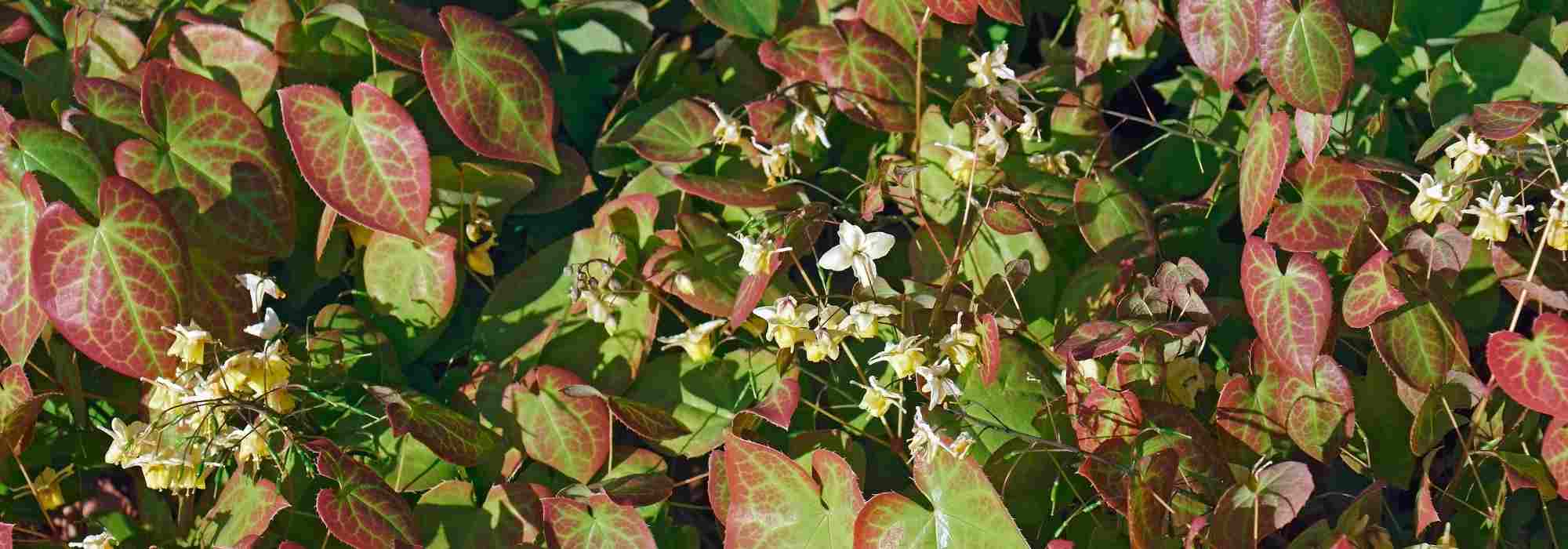
Associating Epimediums: the best companion plants
7 pairing ideas to enhance barrenwort
Contents
Epimediums, charmingly known as barrenworts, are prized for their elegant covering foliage and their very subtle yet decidedly delicate spring flowers, reminiscent of certain orchids. Often evergreen or semi-evergreen, they most commonly serve as ground cover in the dimly lit areas of the garden. Epimediums can also be used in various settings, paired with other plants, always in shaded or partially shaded environments. They will elegantly vegetate neglected spaces with their marbled foliage or blend their lovely flowering with other equally refined perennials in woodlands, in borders, in shady rockeries, and more.
Here are some pairing ideas to showcase Epimediums in the garden!
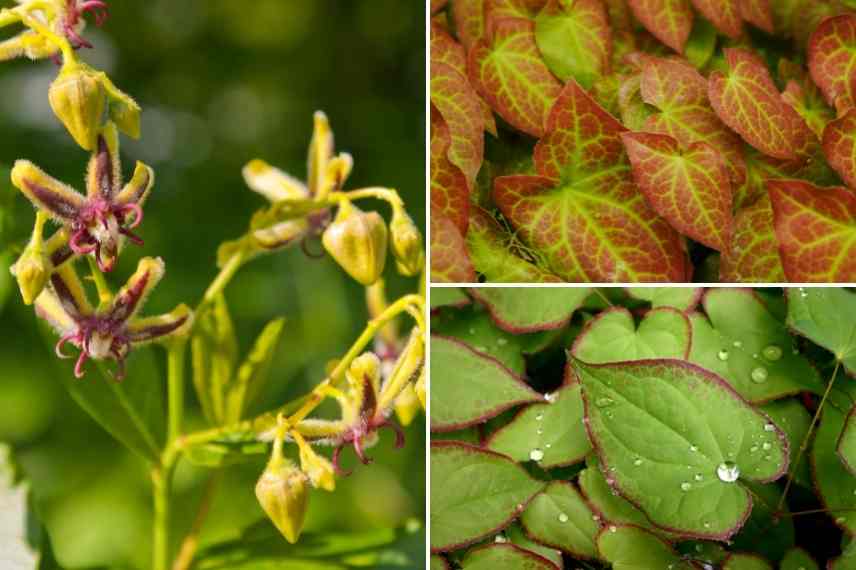 Flowers of the Elves or Epimediums… small plants to integrate into the garden in multiple settings to enjoy their unparalleled beauty!
Flowers of the Elves or Epimediums… small plants to integrate into the garden in multiple settings to enjoy their unparalleled beauty!
→ Also discover our complete guide: Epimedium, Flower of the Elves: planting, growing, and maintaining and How to choose an Epimedium?
Ground cover in woodland
Appreciating humus and cool soils, Epimediums are perfect plants for colonising a woodland or a heavily wooded area where they will find the shade and constant moisture they prefer. They form a subtle yet effective quartet in this setting, with patches of Galium odoratum that will also gradually spread, some wood Spurge (Euphorbia amygdaloides ‘Purpurea’), Geraniums Phaeum flowering a little later, and an assortment of finely cut ornamental ferns such as Polystichum polyblepharum or Dryopteris wallichiana. Some Luzulas nivea may also weave into this forest scene. All will ensure a beautiful cover and a very natural appearance. For this use, choose varieties with evergreen foliage such as Epimedium pubigerum.
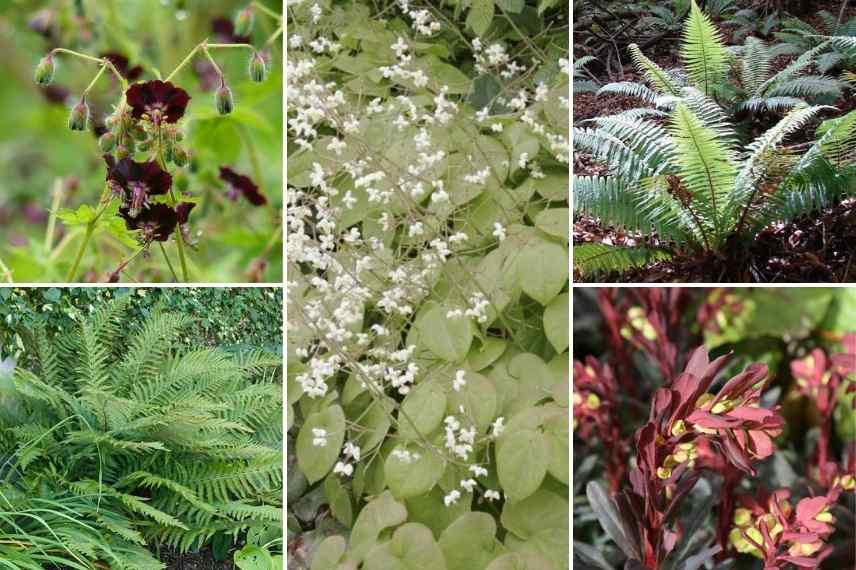
Epimedium pubigerum, alongside Geraniums phaeum ‘Angelina’, Polystichum polyblepharum, Dryopteris wallichiana and Euphorbia amygdaloides ‘Purpurea’
At the foot of the trees
Epimediums thrive in their natural habitat beneath the foliage of trees. The Elf flowers spread through their rootstocks, developing slowly but ultimately forming a beautiful, dense, and opaque ground cover that completely blankets those often challenging areas that can be difficult to manage. They bring undeniable charm in spring with their flowering, which seems to magically emerge from this tapetum, but also throughout the year when choosing evergreen cultivars or living in a mild climate, with their leaves fully covering the soil. For this use at the base of trees, to bring as much brightness as possible, prefer cream or yellow hues, such as Epimedium stellulatum ‘Wudang Star’ with its very airy white inflorescences, or Epimedium davidii with its large bright yellow flowers, and plant them alongside some Eranthis hyemalis, which will also cover the ground well, and Arums italicums, whose flowering, foliage, and then berries ensure a lovely presence throughout the year.

Arums italicum, Epimediums stellulatum ‘Wudang Star’, and a carpet of Eranthis hyemalis
Discover other Epimedium - Barrenwort
View all →Available in 1 sizes
Available in 2 sizes
Available in 2 sizes
Available in 1 sizes
Available in 1 sizes
Available in 1 sizes
Available in 1 sizes
Available in 1 sizes
Available in 2 sizes
Available in 1 sizes
With decorative foliage
The marbled foliage of many varieties of Epimedium is truly beautiful, enhancing the charming heart-shaped laminae with shades of red or brown. The flowers of the elves also have the unique characteristic of changing colour as the leaves renew, making them very interesting perennials for borders where foliage is to be highlighted. By selecting the most spectacular hybrids in terms of colour nuances of the laminae, you can create a scene where the foliage takes centre stage. For example, combine Epimedium x versicolor ‘Sulphureum’, a cultivar with stunning young marbled purple foliage, and Epimedium ‘Warleyense’, marginate with purple in spring and autumn, alongside delicate foliage such as the fern Adiantum pedatum, a few Liriopes with fine linear leaves, and provide a contrast of texture and volume by adding some bolder foliage: Helleborus argutifolius with its tough, dentate pistachio-green foliage, a few Brunneras with silver foliage like the indispensable ‘Alexander’s Great’ with its enormous veined laminae, and a Rodgersia pinnata ‘Hercules’ with its palmate bronze foliage evolving to dark green in summer. By adding a taller stratum with a Sorbaria sorbifolia ‘Sem’ that is almost bicolour, a golden or purple Physocarpus, or even a Sambucus nigra ‘Black Beauty’, you will create a fabulous cocoon of multiple shades of green.
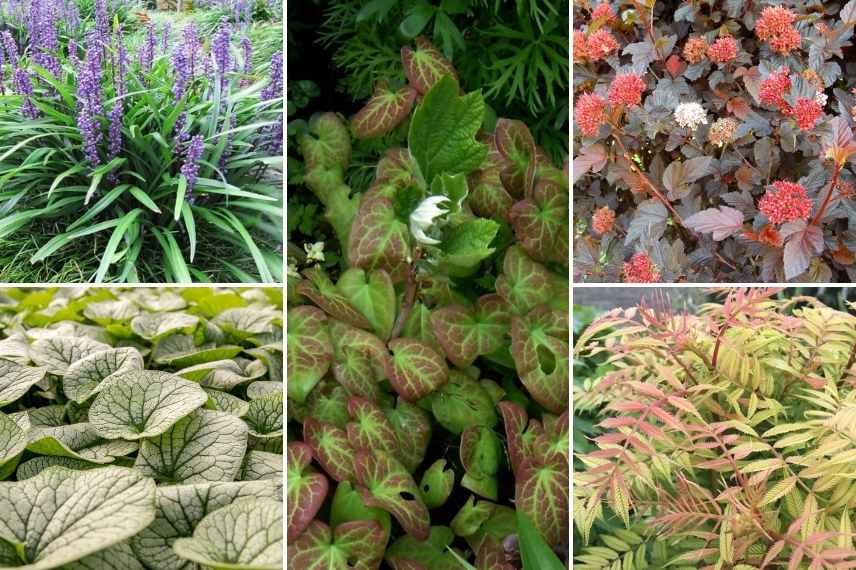
Epimedium x versicolor ‘Sulphureum’, Liriope muscari ‘Majestic’, Brunnera macrophylla ‘Alexander’s Great’, Physiocarpus opulifolius ‘Lady in Red’, and Sorbaria sorbifolia ‘Sem’
With spring bulbs
Flowering in the heart of spring, the carpets of Epimediums create a setting for other blooms emerging from winter. Their delicate and beautiful flowering lasts a relatively short time, so it is interesting to surround them with early and late bulbs that will extend the enchanting effect of spring colours. They should be planted in a semi-shaded to slightly sunny area. You can really explore a wide range of tones, as the elf flowers possess very soft shades, pairing well with many bulb flowers. On a predominantly blue palette of Muscari, Camassias, and Dutch Iris, you could combine the bright yellow of Epimedium perralchicum ‘Frohnleiten’ and enjoy a lovely scene from March to June, or the stunning ‘Akebono’ with its very delicate pink flowers. The flesh pink of Narcissus ‘Reggae’ complements this palette of very soft colours well.
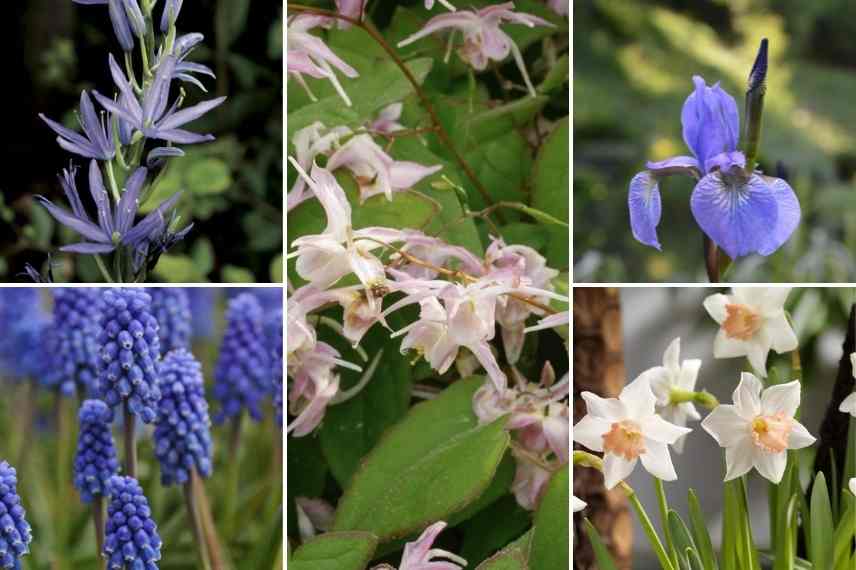
At the centre, Epimedium grandiflorum ‘Akebono’, Camassia leichtinii caerulea, Muscari ‘Dark Eyes’, Dutch Iris, and Narcissus ‘Reggae’
On a more vibrant palette in orange tones, with, for example, the coral of Greigii tulips ‘Toronto’, the apricot of early tulips ‘Apricot Beauty’, and the freshness of Narcissus ‘Avalanche’, Epimedium ‘Amber Queen’ brings its tall yellow and copper flower spikes, creating a beautiful harmony.

Epimediums ‘Amber Queen’, Tulip ‘Apricot Beauty’, Greigii tulip ‘Toronto’, and Narcissus ‘Avalanche’
In a shady border
For this primarily ornamental use, choose new varieties resulting from hybridization, or Asian species that offer remarkable flowering and vividly coloured foliage such as Epimedium x rubrum, with marbled purple foliage in spring, or Epimedium x versicolor ‘Cupreum’, whose leaves also turn reddish, featuring very delicate pink and yellow flowers. You can mix one or two varieties (as they do spread quite a lot over time) with perennials, bushes, or grasses that display a lovely elegance to accompany them: Hellebores, which are also long-lasting, a small Japanese maple, Rhododendrons, Carex… all these plants having the same requirements regarding soil freshness and shaded exposure. Graceful perennials like Bleeding Hearts and Astrantias are also very good companions.
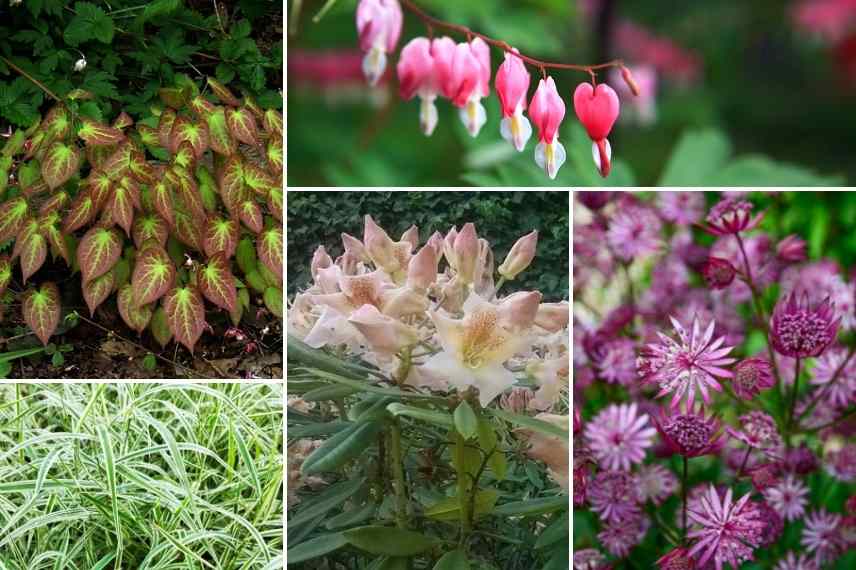
Epimedium rubrum, accompanied by Carex morrowii, Dicentra spectabilis, Rhododendron ‘Inkarho Bernstein’, and Astrantias
In a naturalistic scene
With their discreet presence and ground-covering effect, elf flowers are ideal perennials for natural gardens. Feel free to enhance large spaces that they will colonise relatively quickly. Pair them with some Epimediums ‘Sphinx Twinkler’, which are slightly taller than other varieties and have original, elongated, thorny foliage, along with Epimedium grandiflorum. Gather several wild-looking summer perennials: Persicarias, Lysimachias, and Physostegias that will bloom later in the summer. Complete this wild decor with some Luzula sylvatica and Deschampsia cespitosa ‘Goldschleier’ to bring in airy culms and a controlled meadow feel. This creates a natural and very light atmosphere. A few Scilla Nutans will brighten up this naturalistic scene earlier in spring.
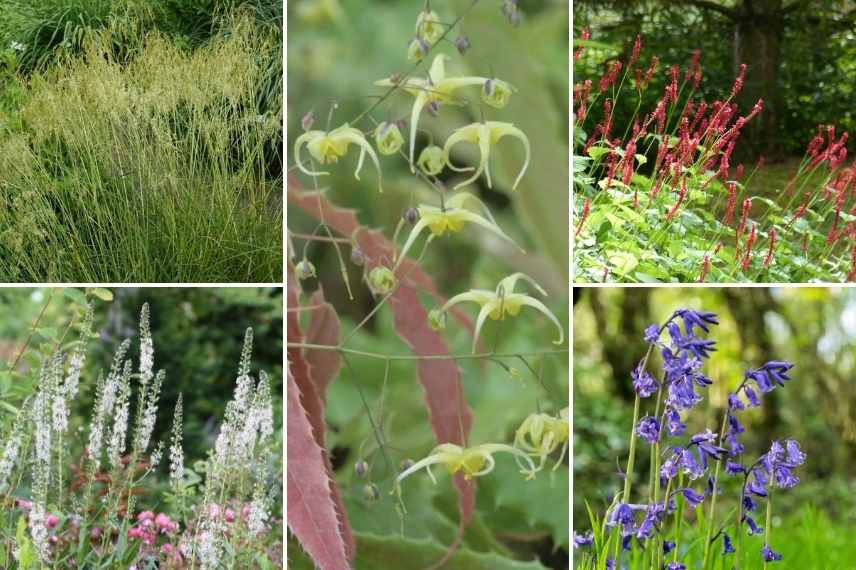
Epimedium ‘Sphinx Twinkler’, Deschampsia cespitosa ‘Goldschleier’, Lysimachia ephemerum, Persicaria amplexicaulis ‘Firetail’, and bluebell
In shady rockeries
The small size of Epimediums and their ability to cover shaded areas with their foliage for long periods also predispose them to enhance shady or semi-shady rockeries. They pair wonderfully with Saxifrages umbrosia ‘Clarence Elliott’, Corydalis in yellow or blue tones, striking low ferns like Asplenium scolopendrium, and miniature Hostas not exceeding 20 cm. For a larger rockery, you can add more finely cut ferns, Lamiums, and a few medium-sized Hostas to vary the volumes. You have plenty of choices for the Epimediums that will form the base of your rockery: why not install a duo of Epimedium pinnatum ‘Black Sea’, whose foliage gradually turns a deep purple, and Epimedium sempervirens, evergreen with lovely pink flowers?

Epimediums (© Leonora Enking) in a shady rockery with dwarf hostas ‘Blue Mouse Ears’, Asplenium scolopendrium ‘Undulatum’, Corydalis lutea, and Saxifrages cortusifolia ‘Cheap Confections’
- Subscribe!
- Contents
![[epimedium-associer value="2"]](https://en.promessedefleurs.eu/blogwp/wp-content/uploads/2021/05/epimedium-associer-2.jpg)































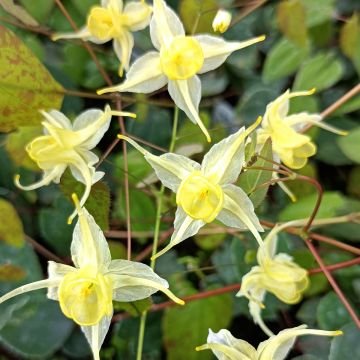
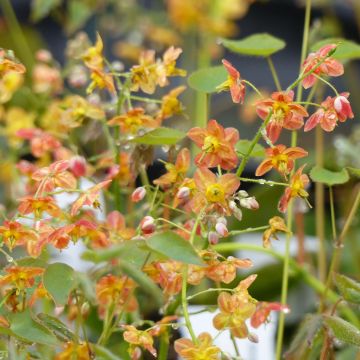
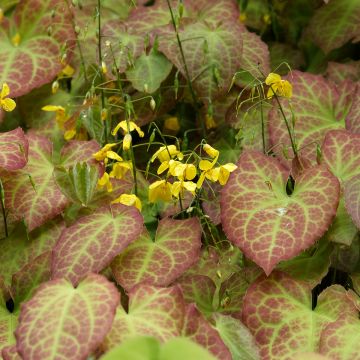
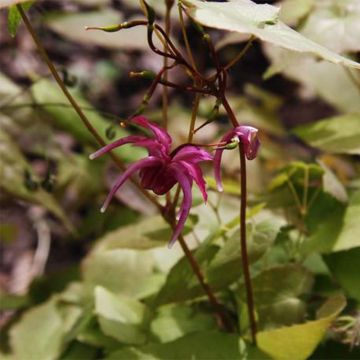
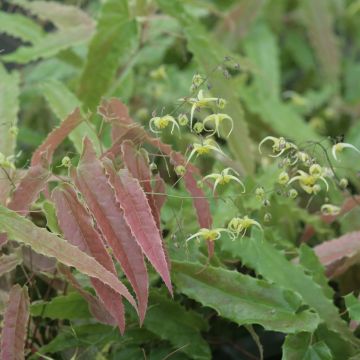
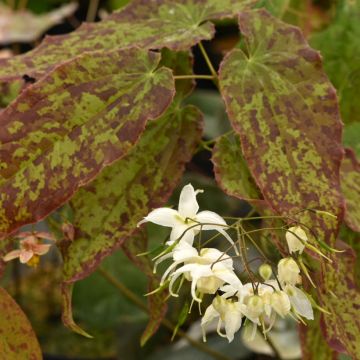
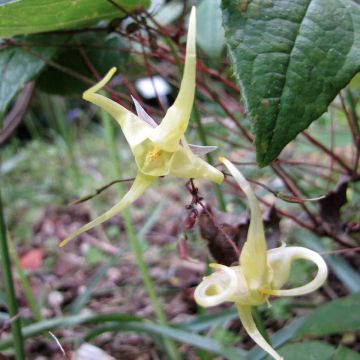

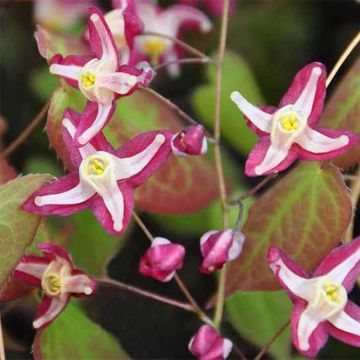
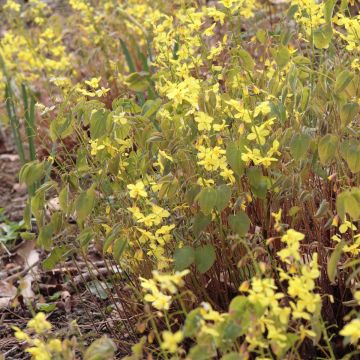
Comments